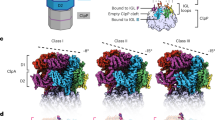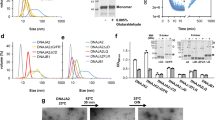Abstract
Molecular chaperones and proteases monitor the folded state of other proteins. In addition to recognizing non-native conformations, these quality control factors distinguish substrates that can be refolded from those that need to be degraded1. To investigate the molecular basis of this process, we have solved the crystal structure of DegP (also known as HtrA), a widely conserved heat shock protein that combines refolding and proteolytic activities2. The DegP hexamer is formed by staggered association of trimeric rings. The proteolytic sites are located in a central cavity that is only accessible laterally. The mobile side-walls are constructed by twelve PDZ domains, which mediate the opening and closing of the particle and probably the initial binding of substrate. The inner cavity is lined by several hydrophobic patches that may act as docking sites for unfolded polypeptides. In the chaperone conformation, the protease domain of DegP exists in an inactive state, in which substrate binding in addition to catalysis is abolished.
This is a preview of subscription content, access via your institution
Access options
Subscribe to this journal
Receive 51 print issues and online access
$199.00 per year
only $3.90 per issue
Buy this article
- Purchase on Springer Link
- Instant access to full article PDF
Prices may be subject to local taxes which are calculated during checkout




Similar content being viewed by others
References
Wickner, S., Maurizi, M. R. & Gottesman, S. Posttranslational quality control: folding, refolding, and degrading proteins. Science 286, 1888–1893 (1999).
Spiess, C., Beil, A. & Ehrmann, M. A temperature-dependent switch from chaperone to protease in a widely conserved heat shock protein. Cell 97, 339–347 (1999).
Gottesman, S., Wickner, S. & Maurizi, M. R. Protein quality control: triage by chaperones and proteases. Genes Dev. 11, 815–823 (1997).
Lipinska, B., Zylicz, M. & Georgopoulos, C. The Htra (Degp) protein, essential for Escherichia coli survival at high temperatures, is an endopeptidase. J. Bacteriol. 172, 1791–1797 (1990).
Pallen, M. J. & Wren, B. W. The HtrA family of serine proteases. Mol. Microbiol. 26, 209–221 (1997).
Zumbrunn, J. & Trueb, B. Primary structure of a putative serine protease specific for IGF-binding proteins. FEBS Lett. 398, 187–192 (1996).
Gray, C. W. et al. Characterization of human HtrA2, a novel serine protease involved in the mammalian cellular stress response. Eur. J. Biochem. 267, 5699–5710 (2000).
Suzuki, Y. et al. A serine protease, HtrA2, is released from the mitochondria and interacts with XIAP, inducing cell death. Mol. Cell 8, 613–621 (2001).
Wootton, J. C. & Drummond, M. H. The Q-Linker—a class of interdomain sequences found in bacterial multidomain regulatory proteins. Protein Eng. 2, 535–543 (1989).
Cabral, J. H. M. et al. Crystal structure of a PDZ domain. Nature 382, 649–652 (1996).
Liao, D. I., Qian, J., Chisholm, D. A., Jordan, D. B. & Diner, B. A. Crystal structures of the photosystem II D1 C-terminal processing protease. Nature Struct. Biol. 7, 749–753 (2000).
Lowe, J. et al. Crystal structure of the 20s proteasome from the archaeon T. acidophilum at 3.4 Å resolution. Science 268, 533–539 (1995).
Bochtler, M., Ditzel, L., Groll, M. & Huber, R. Crystal structure of heat shock locus V (HslV) from Escherichia coli. Proc. Natl Acad. Sci. USA 94, 6070–6074 (1997).
Wang, J. M., Hartling, J. A. & Flanagan, J. M. The structure of ClpP at 2.3 Å resolution suggests a model for ATP-dependent proteolysis. Cell 91, 447–456 (1997).
Larsen, C. N. & Finley, D. Protein translocation channels in the proteasome and other proteases. Cell 91, 431–434 (1997).
Groll, M. et al. A gated channel into the proteasome core particle. Nature Struct. Biol. 7, 1062–1067 (2000).
Brandstetter, H., Kim, J. S., Groll, M. & Huber, R. Crystal structure of the tricorn protease reveals a protein disassembly line. Nature 414, 466–470 (2001).
Doyle, D. A. et al. Crystal structures of a complexed and peptide-free membrane protein-binding domain: molecular basis of peptide recognition by PDZ. Cell 85, 1067–1076 (1996).
Songyang, Z. et al. Recognition of unique carboxyl-terminal motifs by distinct PDZ domains. Science 275, 73–77 (1997).
Misra, R., Castillokeller, M. & Deng, M. Overexpression of protease-deficient DegP(S210A) rescues the lethal phenotype of Escherichia coli OmpF assembly mutants in a degP background. J. Bacteriol. 182, 4882–4888 (2000).
Swamy, K. H. S., Chung, C. H. & Goldberg, A. L. Isolation and characterization of protease Do from Escherichia coli, a large serine protease containing multiple subunits. Arch. Biochem. Biophys. 224, 543–554 (1983).
Strauch, K. L., Johnson, K. & Beckwith, J. Characterization of degP, a gene required for proteolysis in the cell envelope and essential for growth of Escherichia coli at high temperature. J. Bacteriol. 171, 2689–2696 (1989).
Brunger, A. T. et al. Crystallography & NMR system: a new software suite for macromolecular structure determination. Acta Crystallogr. D 54, 905–921 (1998).
Engh, R. A. & Huber, R. Accurate bond and angle parameters for X-ray protein-structure refinement. Acta Crystallogr. A 47, 392–400 (1991).
Jones, T. A., Zou, J. Y., Cowan, S. W. & Kjeldgaard, M. Improved methods for building protein models in electron density maps and the location of errors in these models. Acta Crystallogr. A 47, 110–119 (1991).
Kraulis, P. J. Molscript—a program to produce both detailed and schematic plots of protein structures. J. Appl. Crystallogr. 24, 946–950 (1991).
Merritt, E. A. & Bacon, D. J. in Macromolecular Crystallography Part B 505–524 (Methods in Enzymology, Vol. 277, Academic, New York, 1997).
Evans, S. V. Setor—hardware-lighted 3-dimensional solid model representations of macromolecules. J. Mol. Graph. 11, 134–138 (1993).
Nicholls, A., Bharadwaj, R. & Honig, B. Grasp—graphical representation and analysis of surface properties. Biophys. J. 64, A166–A166 (1993).
Perona, J. J. & Craik, C. S. Structural basis of substrate specificity in the serine proteases. Protein Sci. 4, 337–360 (1995).
Acknowledgements
We thank C. Spiess for providing cells for SeMet expression, and G. P. Bourenkov and J. McCarthy for assistance during data collection at beamlines BW6 (DESY, Hamburg) and ID14-4 (ESRF, Grenoble), respectively. We thank R. A. John and W. Bode for critical reading of the manuscript. Financial support by EU ERB (M.G.-F.), DFG (R.H.) and Aventis (T.C.) is acknowledged.
Author information
Authors and Affiliations
Corresponding author
Ethics declarations
Competing interests
The authors declare that they have no competing financial interests
Rights and permissions
About this article
Cite this article
Krojer, T., Garrido-Franco, M., Huber, R. et al. Crystal structure of DegP (HtrA) reveals a new protease-chaperone machine. Nature 416, 455–459 (2002). https://doi.org/10.1038/416455a
Received:
Accepted:
Issue Date:
DOI: https://doi.org/10.1038/416455a
This article is cited by
-
Structural analysis and rational design of orthogonal stacking system in an E. coli DegP PDZ1–peptide complex
Chemical Papers (2019)
-
Proteases HtrA and HtrB for α-amylase secreted from Bacillus subtilis in secretion stress
Cell Stress and Chaperones (2019)
-
Probiotic Escherichia coli inhibits biofilm formation of pathogenic E. coli via extracellular activity of DegP
Scientific Reports (2018)
-
The crystal structure of Deg9 reveals a novel octameric-type HtrA protease
Nature Plants (2017)
-
The β-barrel assembly machinery in motion
Nature Reviews Microbiology (2017)
Comments
By submitting a comment you agree to abide by our Terms and Community Guidelines. If you find something abusive or that does not comply with our terms or guidelines please flag it as inappropriate.



